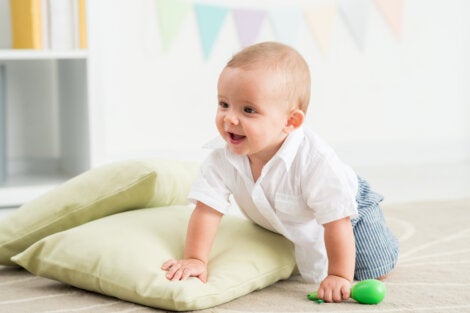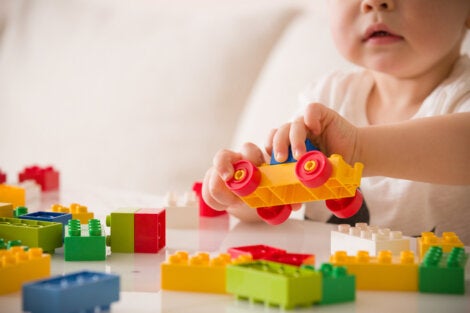Piaget's Sensorimotor Stage of Development

Parents, teachers, and anyone who has spent significant amounts of time with children have observed the developmental process that happens in the first years of their life. That process is the basis for Piaget’s theory of development. The first phase of that process (the sensorimotor stage) is the subject of today’s article.
Psychologist Jean Piaget was the author of one of the most important theories of childhood development ever written. He divided the process by which children develop their cognitive abilities into four stages. The first one, which starts at birth and lasts until the child is about two years old, is especially important due to the impressive amount of progress children make at that age.
Characteristics of the sensorimotor stage of development

Exploration and discovery of their surroundings
During the first two years of life, children start to explore and get to know their surroundings using their senses. Piaget highlights assimilation and accommodation as the primary learning processes. However, to understand these concepts, it’s important to know that children’s brains function on the basis of cognitive structures that change based on their experience.
Therefore, assimilation happens when the child uses their existing cognitive structures to relate to a new object or event. For example, when they suck on a bottle for the first time, they’re using the movement they’ve used to nurse at their mother’s breast.
Accommodation, on the other hand, happens when the new experience doesn’t fit into any of the preexisting cognitive structures. In that case, the structures have to change. This happens when, for example, a child whose concept of family includes father, mother, and children meets a family without a father because the father passed away.
Egocentrism
Another fundamental element of the sensorimotor stage is egocentrism. Children this age are incapable of understanding things from a different point of view. In other words, the child believes that everyone sees, thinks, and feels the same way they do. That means they’ll have to learn to understand their individuality, separate from others and their surroundings.
Object permanence
One of the major developmental milestones of the sensorimotor stage is object permanence. That is, the understanding that objects, people, and events continue to exist even when the child can’t see, hear, or perceive them in any way.
At the end of this stage, the child will be able to understand, for example, that their mother still exists even when she’s out of sight. Before they reach this milestone, the child believes that their mother has simply disappeared.
Substages of the sensorimotor stage
During this entire stage, you can observe the mechanisms that the child uses for cognitive development.
- For the first month of life, the baby relates to their environment primarily through reflexive actions that respond automatically to stimulation.
- Primary circular reactions develop between one and four months. In other words, the child intentionally repeats bodily movements that generate pleasure. Thumb sucking is one example.
- Until 10 months, babies repeat stimulating actions that may or may not have to do with their own bodies. For example, intentionally kicking a noisy toy placed at the end of their crib. These are called secondary circular reactions.
- From 10 to 12 months, children develop the capacity to use their abilities to achieve a goal. For example, moving a cushion that’s covering up a toy they want to play with.
- Tertiary circular reactions happen between 12 and 18 months. Here, the baby starts to vary their behavior and use trial and error to discover new cause and effect relationships.
- Finally, between 18 and 24 months, they develop the ability to make mental reconstructions of objects. This is a basic ability they need to reach the object permanence milestone.

The sensorimotor stage: the beginning of a fascinating journey
This first stage lays the foundation for the child’s future cognitive development. The lessons and skills they acquire in the first two years allow the child to engage with the world. Consequently, this is an enormously important phase of child development. Nevertheless, once this stage is over, a long and fascinating journey of cognitive development still awaits them.
Parents, teachers, and anyone who has spent significant amounts of time with children have observed the developmental process that happens in the first years of their life. That process is the basis for Piaget’s theory of development. The first phase of that process (the sensorimotor stage) is the subject of today’s article.
Psychologist Jean Piaget was the author of one of the most important theories of childhood development ever written. He divided the process by which children develop their cognitive abilities into four stages. The first one, which starts at birth and lasts until the child is about two years old, is especially important due to the impressive amount of progress children make at that age.
Characteristics of the sensorimotor stage of development

Exploration and discovery of their surroundings
During the first two years of life, children start to explore and get to know their surroundings using their senses. Piaget highlights assimilation and accommodation as the primary learning processes. However, to understand these concepts, it’s important to know that children’s brains function on the basis of cognitive structures that change based on their experience.
Therefore, assimilation happens when the child uses their existing cognitive structures to relate to a new object or event. For example, when they suck on a bottle for the first time, they’re using the movement they’ve used to nurse at their mother’s breast.
Accommodation, on the other hand, happens when the new experience doesn’t fit into any of the preexisting cognitive structures. In that case, the structures have to change. This happens when, for example, a child whose concept of family includes father, mother, and children meets a family without a father because the father passed away.
Egocentrism
Another fundamental element of the sensorimotor stage is egocentrism. Children this age are incapable of understanding things from a different point of view. In other words, the child believes that everyone sees, thinks, and feels the same way they do. That means they’ll have to learn to understand their individuality, separate from others and their surroundings.
Object permanence
One of the major developmental milestones of the sensorimotor stage is object permanence. That is, the understanding that objects, people, and events continue to exist even when the child can’t see, hear, or perceive them in any way.
At the end of this stage, the child will be able to understand, for example, that their mother still exists even when she’s out of sight. Before they reach this milestone, the child believes that their mother has simply disappeared.
Substages of the sensorimotor stage
During this entire stage, you can observe the mechanisms that the child uses for cognitive development.
- For the first month of life, the baby relates to their environment primarily through reflexive actions that respond automatically to stimulation.
- Primary circular reactions develop between one and four months. In other words, the child intentionally repeats bodily movements that generate pleasure. Thumb sucking is one example.
- Until 10 months, babies repeat stimulating actions that may or may not have to do with their own bodies. For example, intentionally kicking a noisy toy placed at the end of their crib. These are called secondary circular reactions.
- From 10 to 12 months, children develop the capacity to use their abilities to achieve a goal. For example, moving a cushion that’s covering up a toy they want to play with.
- Tertiary circular reactions happen between 12 and 18 months. Here, the baby starts to vary their behavior and use trial and error to discover new cause and effect relationships.
- Finally, between 18 and 24 months, they develop the ability to make mental reconstructions of objects. This is a basic ability they need to reach the object permanence milestone.

The sensorimotor stage: the beginning of a fascinating journey
This first stage lays the foundation for the child’s future cognitive development. The lessons and skills they acquire in the first two years allow the child to engage with the world. Consequently, this is an enormously important phase of child development. Nevertheless, once this stage is over, a long and fascinating journey of cognitive development still awaits them.
All cited sources were thoroughly reviewed by our team to ensure their quality, reliability, currency, and validity. The bibliography of this article was considered reliable and of academic or scientific accuracy.
- Piaget, J. (2003). Part I: Cognitive Development in Children–Piaget Development and Learning. Journal of research in science teaching, 40.
- Huitt, W., & Hummel, J. (2003). Piaget’s theory of cognitive development. Educational psychology interactive, 3(2), 1-5.
This text is provided for informational purposes only and does not replace consultation with a professional. If in doubt, consult your specialist.







